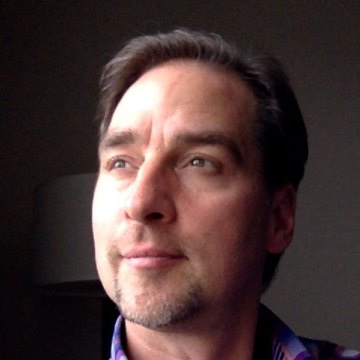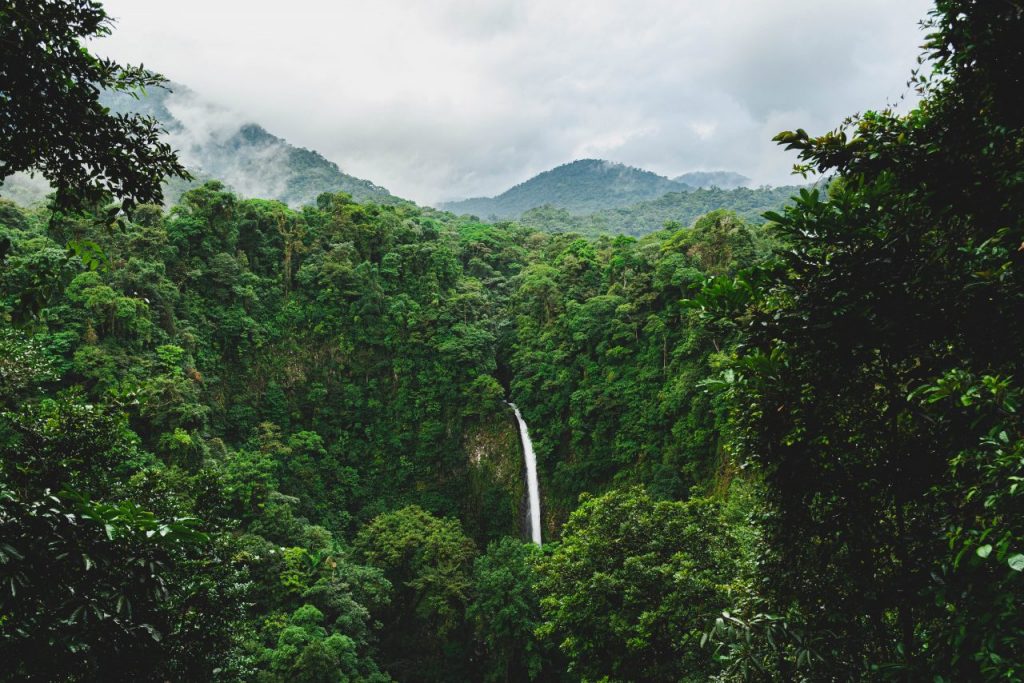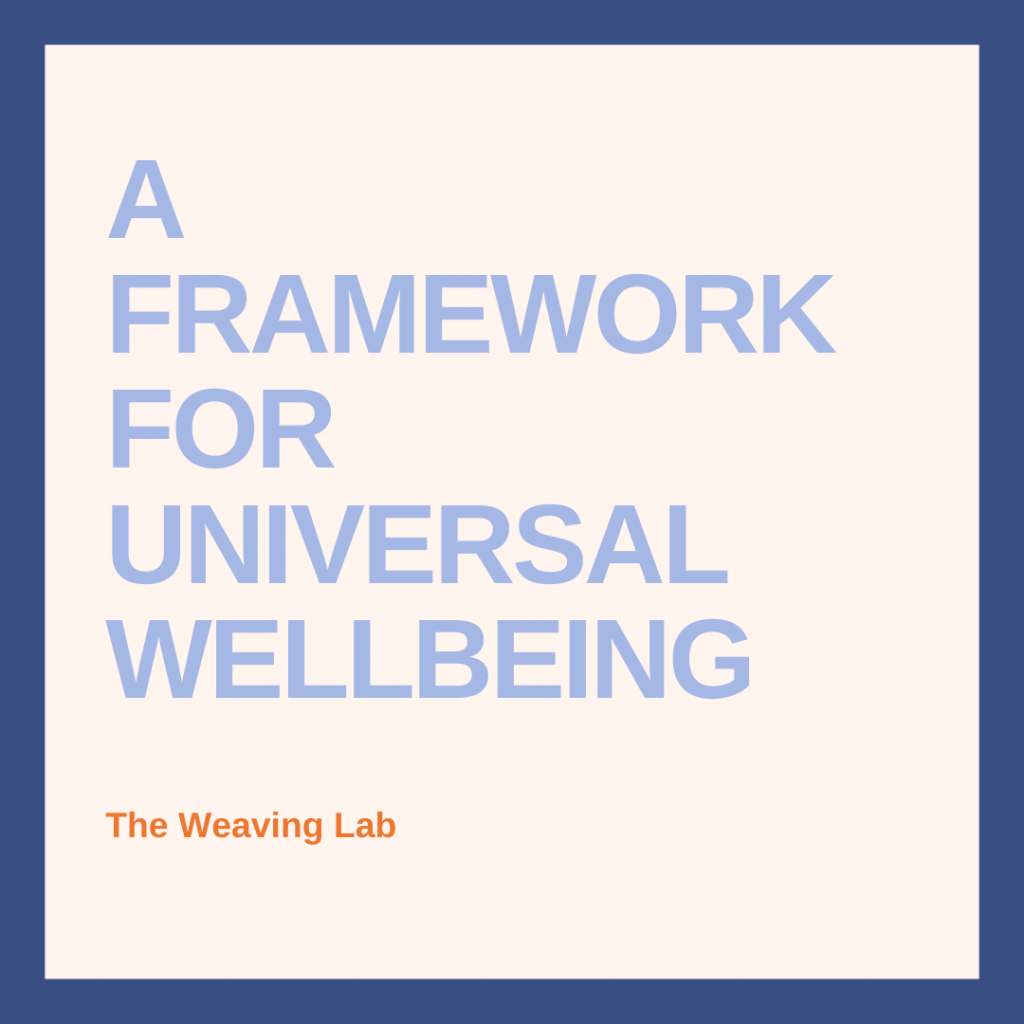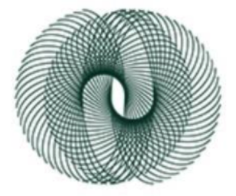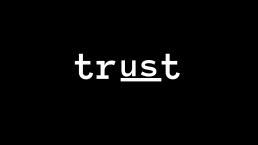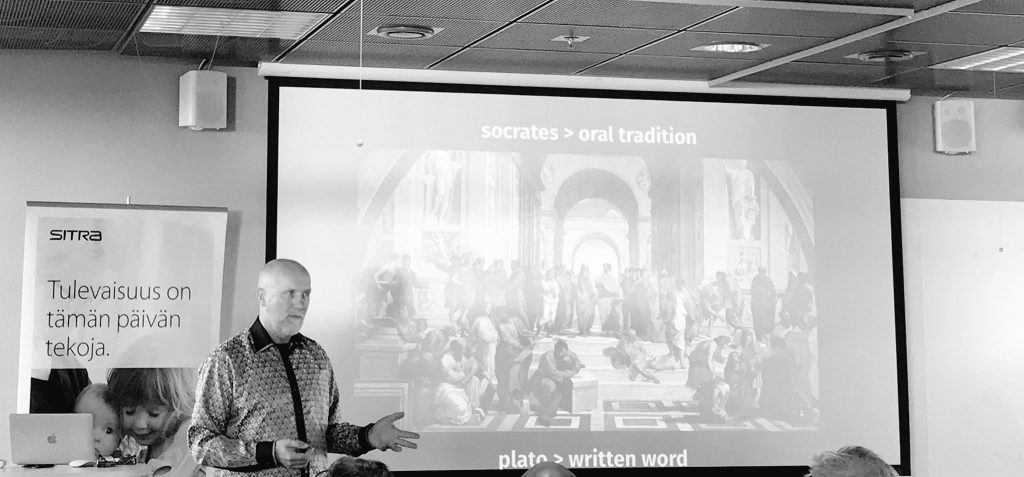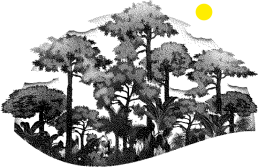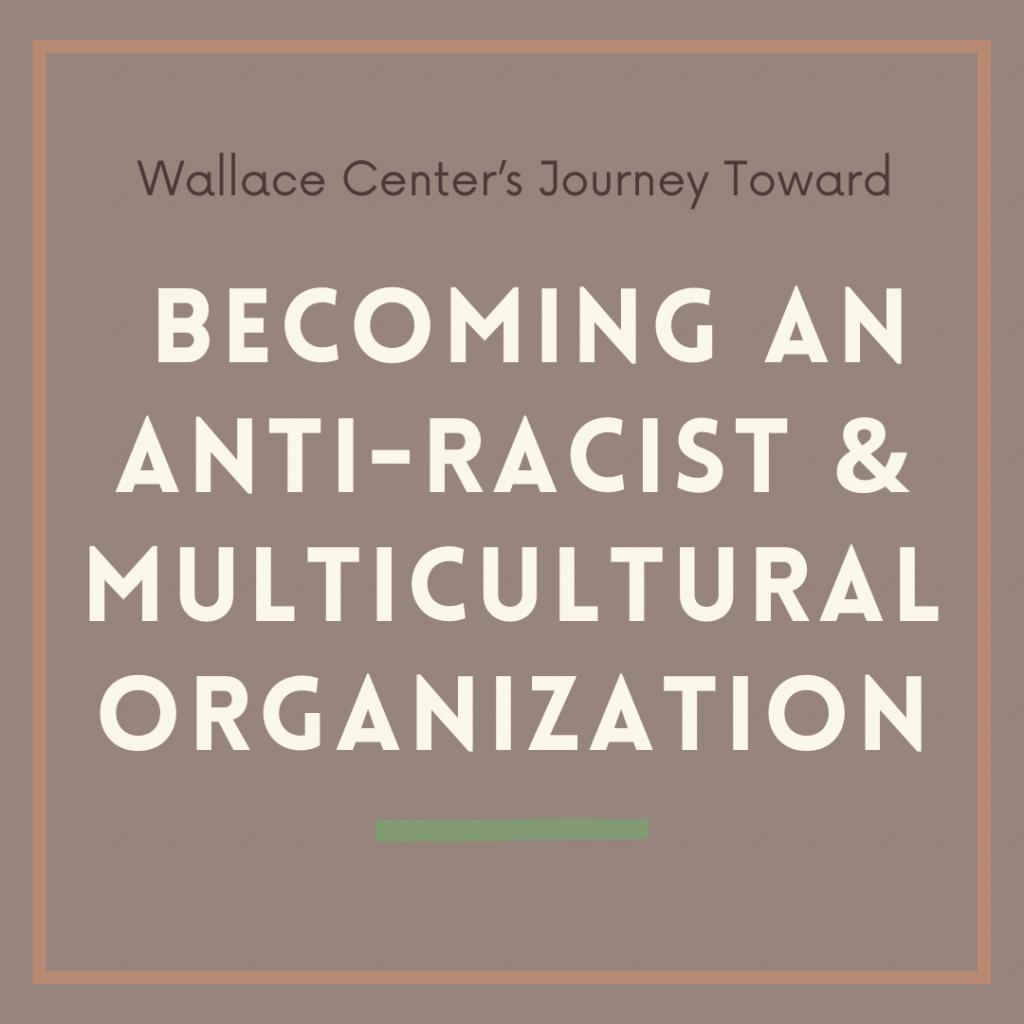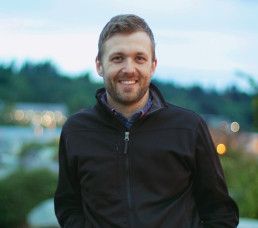Thinking Like an Octopus (and With a Collaborative Heart): Evolving and Interlocking Networks
June 7, 2021Network Weaving,Network Structure and Governance,Network Mindset,Network Processes,Blog
“You’ve got to keep asserting the complexity and the originality of life, and the multiplicity of it, and the facets of it.”
Toni Morrison
A network that I have been a part of for a number of years is seeing the emergent proliferation and strengthening of other related networks (some more adjacent than others) in its shared geographic and issue spaces. While this is welcomed overall, and sets up the potential for a more robust movement network and core-periphery structure (see image below), there are also some discussions within the network about how this proliferation constitutes an opportunity versus a looming threat or conflict.
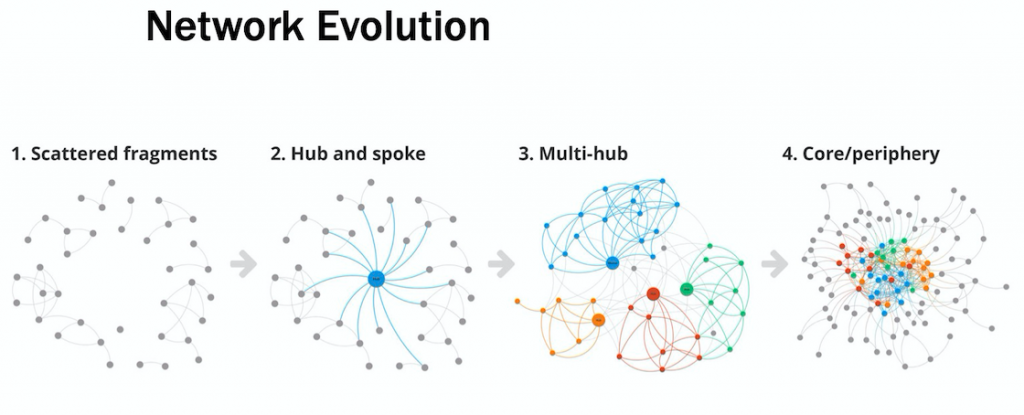
There is plenty being written about the power of collaboration to solve complex problems and shift undesirable patterns, and one of the persistent barriers to collaboration is the default competitive and protective instinct found in individuals and groups. There are good and long-standing evolutionary reasons for “watching out for number one,” so this impulse can be fairly baked in. And there are also good reasons for understanding and leaning into “collaborative advantage” (see, for example, the work of evolutionary biologist David Sloan Wilson on multi-level selection).
“One step is to recognize that ‘ideologies extolling individualism, competition, untrammeled free markets, and conversely, disparaging cooperation and equality’ (as Turchin puts it) have no scientific justification. An unregulated organism is a dead organism, for the body politic no less than our own bodies.”
David Sloan Wilson
And of course, there are plenty of examples of “taking the high road” only to have someone else take advantage of this, which can leave us feeling like we are living in the prisoner’s dilemma. So what is a network to do? Well, if your values include collaboration and justice, then you do your best to lead by example. Which is where a recent network stewardship team conversation left us. And as often happens with this group, things continued to marinate and then one of our members sent the following beautiful email, reminding us of her experiences in a related network of networks.
“The dynamics we discussed reminded me a lot of what we have experienced at our organization since 2009, so if you’ll indulge me for a few minutes I’ll try to lay it out here. In late 2007, we piloted a new cooperative venture and launched the FL Collaborative in 2009. Our vision and aspirations were to bring a cross sector of people and organizations together to address the root causes of the problems facing our sector and relevant communities.
One of the first things the FL Collaborative really wanted to focus on was replicating the cooperative model, and our organization was tasked with doing that. And we did. Pretty soon it became clear that we couldn’t both do that and hold the bigger vision and aspirations. But to be honest, I didn’t want to admit that.
By 2011, the LC Network started to emerge from the FL Collaborative. My first reaction was that we have competition. But very soon it became clear that the LC Network was serving a role our staff and the FL Collaborative couldn’t serve. The LC Network was beginning to pull together elements of what it takes to shift the supply chain from one that is value-less to one that is value-full. The kind of technical support the sector and visionaries needed began to emerge through the LC Network.
By 2014, the SF Network (another network) began to percolate out of the FL Collaborative. And again I found myself triggered by the potential competition. What the SF Network was beginning to offer was the ‘social’ space. When our organization and the FL Collaborative were hosting a series of community gatherings and various social events that allowed us to have a public facing part, SF was emerging as being able to offer that. Another thing we could take off of our staff’s plate so we can focus on our bigger vision and aspirations.
The FL Collaborative, in the meanwhile, began to morph into the political and advocacy space. That’s where we think through policy shifts, organizing opportunities, connectivity, and alignment around the broader vision of what the future of the sector and larger system can look like and what it might take to get us there. Those who are engaged in each of these networks are doing things that they can easily wrap their heads around and inspires them most.
Today, I talk about these three networks as three tentacles of an octopus with our organization holding the space of the head of the octopus. Because our staff was not liberated to focus more fully on the shared values, bigger vision, the bigger story, connectivity, etc., all these three networks are interlocked by a shared set of values, a common vision, and organizing strategies.
Our staff are the ones who are asking the bigger questions of each of these networks when they seem to go off track. We are the ones who are finding the resources needed to get them to think about how racial equity is or isn’t showing up there (and we get most of that from [the network for which the readers of the email are the stewardship team]). So without sounding too egotistical, our staff is tasked with holding the moral center of all of this work whether it comes to the connections, strategies, resources, stories, organizing, etc. There is probably a better word than the moral center, but that’s the only thing that is coming to me right now.
More tentacles might emerge, and I hope they do as we identify gaps in this work. And I hope I can remain humble enough to not see them as competition but as a valuable addition to the family.“
It takes work, real intention and effort, to stay grounded and humble, to practice discernment and to keep perspective, to keep asserting the larger picture of complexity, to honor the need for deeper collaboration and more allies, to have faith in the possibilities that we cannot yet see through the growing entanglement of intersections. Even better when you can depend on others to help you out with this! With #gratitude to so many.
“Weave real connections, create real nodes, build real houses.
Live a life you can endure: Make love that is loving.
Keep tangling and interweaving and taking more in,
a thicket and bramble wilderness to the outside but to us
interconnected with rabbit runs and burrows and lairs.Live as if you liked yourself, and it may happen:
reach out, keep reaching out, keep bringing in.
This is how we are going to live for a long time: not always,
for every gardener knows that after the digging, after
the planting,
after the long season of tending and growth, the harvest comes.”
Marge Piercy, from her poem “Seven of Pentacles”

Originally published at Interaction Institute for Social Change
Featured Image from Giulian Frisoni
Curtis Ogden is a Senior Associate at the Interaction Institute for Social Change (IISC). Much of his work entails consulting with multi-stakeholder networks to strengthen and transform food, education, public health, and economic systems at local, state, regional, and national levels. He has worked with networks to launch and evolve through various stages of development.
PLEASE DONATE to help Network Weaver continue in it’s mission to offer free support and resources to networks worldwide.
Map Analysis & Weaving
June 1, 2021Reflection and Learning,Blog
Many networks (and especially funders of networks) dive into the process of generating network maps without much thought about how they will be used. The resulting maps too often end up never being seen or used by network participants. It's really a shame as network maps are extremely powerful tools that can be used to weave very healthy and effective networks. However, network mapping needs to be combined with a strategy for engaging network participants in interpreting the maps and then developing strategies for connecting people in the network and drawing in new participants.
This slide deck is about a network - the Innovation Learning Network (a network of hospital systems across the U.S.) - that implemented a highly effective strategy to use their maps.
Several aspects of their strategy that are worth emulating:
1. The network had hired two network weavers but those network weavers did not take on the mapping and weaving job alone. They recruited about 25 network participants who were interested in learning more about network weaving to implement their weaving strategy.
2. The entire group spent time reading and analyzing the network maps and then, based on that analysis, generating a set of activities that would help the network become a healthy and effective self-organizing network.
3. In addition to the network weavers connecting people, they set up a set of network activities that would enable network participants to get to know more people in the network, add new people to the network, and help people find others interested in the same topic or action areas.
4. They found that the most powerful strategy for improving their network was to support self-organizing: helping people find others interested in a particular exploration or action not only resulted in people in that project getting to know each other quite deeply but also showed them the power of self-organizing. As a result, many many new initiatives were generated over the years that took little staff time to coordinate and yet changed the face of the healthcare industry.
5. ILN remapped their network several times to notice progress and to see areas where they needed to focus their network weaving.
6. They gathered information about the effectiveness of this network enhancing strategy.
What questions do you have about this strategy? How might you adopt and adapt the ideas presented in this case study. Feel free to share this slide deck with your local network or your funders.
Finally, I'd love to hear about ways that you used your network maps. Please share with us in the comments section below.
featured image found here
June Holley has been weaving networks, helping others weave networks and writing about networks for over 40 years. She is currently increasing her capacity to capture learning and innovations from the field and sharing what she discovers through blog posts, occasional virtual sessions and a forthcoming book.
PLEASE DONATE to help Network Weaver continue in it’s mission to offer free support and resources to networks worldwide.
The Story of the Clouds and the Forest
May 25, 2021Blog,Transformation
There’s a story one often hears in conversations about systemic transformation that goes like this…
We are headed in the wrong direction and there’s very little time to reverse course. Because of the scale and speed of the change that is required, the hundreds of thousands (or even millions) of small groups currently working towards change can’t possibly get us where we need to go. They are too fragmented. They compete with each other and duplicate efforts. They can’t leverage enough resources or influence to challenge the entrenched power of the status quo. To fix this problem, we must concentrate our support on a smaller number of much larger groups. And those groups must also do a lot more collaborating and coordinating than is currently taking place.
What if that story is the equivalent of missing the forest for trees?!
As we now know, that is literally the mistake scientists were making before they understood how collaborative, intelligent, and symbiotic forests truly are. We can use this metaphor to write a new story of systemic transformation, and the role of funding in supporting it.
As the old industrial growth paradigm dies back, a new collaborative and regenerative one is emerging all around us. Like trees in a forest, the myriad initiatives based on this paradigm are not simply small, separate entities, competing with one another for scarce resources. They comprise multiple ecosystems than can hold, distribute, and recycle the money they use to do their work. They can move at the speed of trust, which is the only way to head in a regenerative direction.
When clouds rain on a mature forest, the forest allocates the water, based on a complex set of relationships and structures that have evolved over long periods of time. Forests even release chemical signals that seed clouds and help trigger them to drop their moisture. The clouds do not get down on the ground and study the lakes, rivers, and soil to figure out where their water will do the most good or where it might cause erosion. Nor do they create their own water management infrastructure to contain, release, and evaluate the impact of the essential resource that they provide.
Funders of transformation must act like clouds if they wish to nourish whole ecosystems of change. The task is far too complex to be managed from the top down. Even the most well-intentioned of funders face huge challenges in sensing what is needed on the ground, especially at the edges and at the community level, where transformational potential is greatest. Many funders who wish to support systems change now understand the limitations of their decision-making capacity. They recognize that “deep democracy” is part of the DNA of a Just Transition and are trying out new, participatory approaches that center the grassroots. This shift in the funding world might be poised to spread widely as stories about it are shared.
Meanwhile, networks of people and organizations that are committed to transformational work have been developing the capacity to act like forests. They have built up trust-based soil through decades of work, learning from successes and composting failures. That soil is now home to a vast mycelial network of relationships, capable of moving information and nutrients in highly complex ways. This has given rise to diverse ecosystems of initiatives, ready to grow and mature if they receive sufficient nourishment. In order to call for that nourishment, these ecosystems are learning processes of democratic governance so they can move, store, and recycle money in collaborative ways, prioritizing cooperation and symbiosis to generate more opportunities for all.
What would happen if more funders chose to act like clouds, and trusted the forests they wished to see thrive? What would happen if more fundees doing the work on the ground trusted that they were parts of forests and sent collective signals that they were ready for rain? Perhaps we would find that these emerging forests are far mightier, more widespread, and more mature than we realized. Perhaps we would discover that the speed of trust is much faster than we thought. Or that we have actually also been traveling in the right direction for a very long time.
~~~
This post was written as part of the invitation process for the TRCC Collaborative Funding Dojo, which runs from May 17-June 30th. Please join us if the ideas expressed here call to you and your wish to learn and practice ways to act on it, or share stories about how you are already doing so.
Originally posted at thrivingresilience.org
Photo by Etienne Delorieux on Unsplash
I am a systemic change agent and a process artist. Since March 2009, when I began leading a local weekly “Discussion Salon,” I have been convening and hosting both in-person and virtual conversations on a regular basis, in service to initiatives for change.
PLEASE DONATE to help Network Weaver continue in it’s mission to offer free support and resources to networks worldwide.
A Framework For Universal Well Being
May 18, 2021The Big Picture,Reflection and Learning,Blog,Transformation
A note from the Editor: What follows is generously brought to you by The Weaving Lab and taken directly from their Framework for Universal Well Being. You can download the full document on their site, or HERE at NW.com.
INTRODUCTION
The Weaving Lab is a global community of weavers and other change leaders who are weaving empowering ecosystems for universal wellbeing.
Our central beliefs are:
• Universal wellbeing is humanity’s deepest purpose and highest aspiration
• Everyone should be empowered (equipped and inclined) to live for universal wellbeing (to practice changemaking)
• Living for universal wellbeing means choosing and acting, from moment to moment, to achieve the optimal balance between the wholly interdependent and ever-fluctuating variables that constitute personal, socio-economic and planetary wellbeing
• Every human system should have Universal Wellbeing as its central purpose - and be thought of as an empowering learning ecosystem (a system which, through the choices and actions of those in the system, senses and improves itself continuously)
• To create and improve any empowering learning ecosystem that is directed towards Universal Wellbeing, a critical mass of people in the system need to be consciously and continuously weaving change
Our mission is to weave a global learning ecosystem of weavers who are advancing the profession and practice of weaving thriving learning ecosystems.
Weaving involves:
• Aligning people: To a shared vision and values
• Fostering collaborations: Organising for collective impact
• Thinking and acting systemically
• Being a better system
To achieve our mission, we have developed this Framework to guide and inform our own work and to support change leaders anywhere in weaving empowering learning ecosystems.
Our hope is that this Framework will be used as:
• A rigorous line of enquiry for creating clarity (individually and within groups)
• A departure-point for conversation, reflection and learning
• A structure for organising and sharing stories and evidence
The Framework would not have come about without the contributions from change leaders around the world. Informed by thousands of conversations with some of the world’s most visionary thinkers and practitioners, it has been impossible to find words that perfectly accommodate everyone’s unique perspective or chosen language. The Framework should be read, therefore, as a synthesis of interconnected and overlapping ideas, and as a work in progress that will improve with constructive critique.
THE FRAMEWORK
1. UNIVERSAL WELLBEING
What does it mean to thrive?
2. THRIVING IN THE NEW WORLD
What do we have to contend with to move towards Universal Wellbeing?
3. BEING WELL AND DOING GOOD
How does human action influence Universal Wellbeing?
4. BEING EMPOWERED TO PRACTICE CHANGEMAKING
What does it mean to live for Universal Wellbeing?
5. BECOMING EMPOWERED TO PRACTICE CHANGEMAKING
How do people become empowered to live for Universal Wellbeing?
6. EMPOWERING LEARNING ECOSYSTEMS
What systemic changes are necessary to empower everyone to live for Universal Wellbeing?
7. WEAVING EMPOWERING LEARNING ECOSYSTEMS
How will systems change?
1. UNIVERSAL WELLBEING
What does it mean to thrive?
1.1. Our deepest purpose and highest aspiration: Wellbeing, quality of life, flourishing, and thriving.
1.2. Interconnectedness and interdependence: Personal, socio-economic and planetary wellbeing together
1.3. Personal wellbeing
- 1.3.1. Health (physical and mental)
- 1.3.2. Safety and security
- 1.3.3. Calm and comfort
- 1.3.4. Autonomy, freedom and competence
- 1.3.5. Self-esteem
- 1.3.6. Achievement and personal growth
- 1.3.7. Purpose and meaning
- 1.3.8. Hope and optimism
- 1.3.9. Understanding and feeling understood
- 1.3.10. Feeling interested
- 1.3.11. Playing
- 1.3.12. Caring and feeling cared for
- 1.3.13. Loving and feeling loved
- 1.3.14. Intimacy and sex
- 1.3.15. Belonging and respect
- 1.3.16. Being fairly treated
- 1.3.17. Appreciation and wonder
- 1.3.18. Happiness
1.4. Socio-economic wellbeing
- 1.4.1. Family, friends, community, relationships
- 1.4.2. Social systems
- 1.4.3. Work, money and standard of living
- 1.4.4. Rights, laws and social norms
1.5. Planetary wellbeing
- 1.5.1. Sustainability
- 1.5.2. Regeneration
2. THRIVING IN THE NEW WORLD
What do we have to contend with to move towards Universal Wellbeing?
2.1. The state of the world
2.2. Volatility, uncertainty, complexity and ambiguity
2.3. Mass distribution and mass participation
2.4. AI, automation and the 4th industrial revolution
2.5. Hyper-connectivity
2.6. New consciousness
3. BEING WELL AND DOING GOOD
How does human action influence Universal Wellbeing?
3.1. The consequences of human action: Everyone shapes the world
3.2. Intention, choosing, deciding, acting and behaviour
- 3.2.1. Consciousness, the unconscious and agency
- 3.2.2. Motivation
- 3.2.3. Emotions, moods and feelings
- 3.2.4. Needs and wants
- 3.2.5. Beliefs and values
- 3.2.6. Cognitive biases
- 3.2.7. Memory, self-identity and ego
4. BEING EMPOWERED TO PRACTICE CHANGEMAKING
What does it mean to live for Universal Wellbeing?
4.1. Being empowered: Knowledge, skills, attitudes, values, competences, qualities and potentialities
4.2. Being empowered: Ways of being 4.2.1. Being empathic and compassionate
- 4.2.2. Being self-aware and self-controlled
- 4.2.3. Being present, attentive and mindful
- 4.2.4. Being reflective and future-minded
- 4.2.5. Being helpful, kind and generous
- 4.2.6. Being open-minded, flexible and fair-minded
- 4.2.7. Being collaborative
- 4.2.8. Being communicative, assertive and civil
- 4.2.9. Being tolerant, patient and forgiving
- 4.2.10. Being courageous
- 4.2.11. Being resilient
- 4.2.12. Being conscientious, organised and efficient
- 4.2.13. Being proactive
- 4.2.14. Being possibility-minded
- 4.2.15. Being responsible
- 4.2.16. Being authentic, sincere and honest
- 4.2.17. Being adaptable, curious and growth-minded
- 4.2.18. Being imaginative, creative and resourceful
- 4.2.19. Being reasonable, critical and questioning
- 4.2.20. Being thoughtful, ethical and wise
5. BECOMING EMPOWERED TO PRACTICE CHANGEMAKING
How do people become empowered to live for Universal Wellbeing?
5.1. Being, becoming and learning
5.2. Genetics, personality, neuroplasticity and experience
5.3. Empowering learning experiences
- 5.3.1. Practicing changemaking daily
- 5.3.2. Reflecting on practice and progress
- 5.3.3. Being trusted to take the lead
- 5.3.4. Working in the community
- 5.3.5. Doing projects that are self-directed, collaborative, immersive, experiential, interdisciplinary, and challenge-based
- 5.3.6. Being in nature
- 5.3.7. Using technology
- 5.3.8. Exploring the sustainable development goals
- 5.3.9. Debating the state of the world
- 5.3.10. Questioning the status quo
- 5.3.11. Exploring and celebrating diversity
- 5.3.12. Practicing peace-making
- 5.3.13. Playing, making art and telling stories
- 5.3.14. Discussing holistic human development
- 5.3.15. Practicing meditation and mindfulness
5.4. Monitoring and measuring progress
6. EMPOWERING LEARNING ECOSYSTEMS
What systemic changes are necessary to empower everyone to live for Universal Wellbeing?
6.1. 1st line actors directly influence the experience of others
6.2. 2nd line actors indirectly influence the experience of others
6.3. Collaboration at every scale is essential
6.4. Complex systemic changes are required
6.5. Changing systemic mechanisms and mindsets
- 6.5.1. Building trust, enhancing communication, raising voices
- 6.5.2. Creating new roles, empowering every actor
- 6.5.3. Building capacity in the system
- 6.5.4. Changing progression routes and incentives
- 6.5.5. Changing policies
- 6.5.6. Shifting funding
- 6.5.7. Applying technologies
- 6.5.8. Changing measures
- 6.5.9. Redefining success
- 6.5.10. Shifting mindsets and behaviours
7. WEAVING EMPOWERING LEARNING ECOSYSTEMS
How will systems change?
7.1. Everyone contributes to change
7.2. Change leaders lead the way
7.3. Vibrant communities and effective teams will be crucial
7.4. Change leaders must align, collaborate and act systemically
7.5. Weaving is essential to continuous change 7.5.1. Aligning communities to a shared North Star
- 7.5.2. Fostering collaborations and organising
- 7.5.3. Weaving involves building conversations and demand
featured image found at ssir.org
The Weaving Lab trains leaders, cultivates research, builds networks and advises organisations working to weave thriving communities.
The Weaving Lab is growing the field of weaving – deepening its practice, advancing research, and strengthening the community of practitioners – so that together, we can effect systems change that enable people and planet thrive.
PLEASE DONATE to help Network Weaver continue in it’s mission to offer free support and resources to networks worldwide.
Trust Emerges Over Time
May 11, 2021Network Mindset,Blog,Equity
Imagine a research-intensive organization where scientists should be sharing what they learn, and the official company policy is to share information and expertise among public and private partners. However, the company is ‘downsizing’ and layoffs are based on performance reviews. If one scientist helps a peer develop a patented product, and as a result the peer gets a better annual review, then the former may end up losing their job during the next round of layoffs. This was the situation I found myself in a decade ago.
Sharing knowledge was not a good personal strategy in this work environment even though it was official policy and was the focus of our project. We could not achieve our project objectives because systemic barriers pitted workers against each other in order to remain employed.
In this case, financial rewards for patents impeded learning, and in the end halted any knowledge sharing. In complex systems, the solutions are never simple, but our only hope is learning how to learn better and faster — individually, in teams, as an enterprise, and as a society. If we want to promote learning through knowledge sharing we should first look at what is blocking it.
Stan Garfield recently posted 16 reasons why people don’t share their knowledge. Of these 16 reasons most are due to a lack of information, tools, incentives, or motivation. These are systemic barriers to knowledge sharing. Only a few are due to a lack of skills or knowledge, which could be addressed through formal, informal, or social learning.

In my experience the core issue is trust, which Stan outlines in his second point.
2. They don’t trust others. They are worried that sharing their knowledge will allow other people to be rewarded without giving credit or something in return, or result in the misuse of that knowledge.
When trust is lost, knowledge fails to flow. When knowledge flow is stemmed, trust is lost. This happens in organizations. It also happens at a societal level. Networks of trust are what create value at all levels for human society.
“It is important to stress that we are all connected through a complicated net of trust. It is not as if there is a group of people, the non-experts, who have to trust the experts and the experts do not have to trust anyone. Everyone needs to trust others since human knowledge is a joint effort. The most poisonous effects of social media may not be the spread of disinformation per se but the undermining of trust that comes from anger and division. It is well known that low levels of trust in a society leads to corruption and conflict, but it is easy to forget the very central role that trust plays for knowledge. And knowledge, of course, is essential to the democratic society. As the historian Timothy Snyder has said, post-truth is pre-fascism.” —Why do we resist knowledge?
Openness enables transparency and knowledge-sharing, which fosters diversity of opinions, and these reinforce social networks. First we create open structures, more networked than hierarchical, with freedom to move across teams. Then we promote transparency by discouraging gatekeepers and identifying knowledge bottlenecks. This openness can encourage diversity of ideas and people. It is only over time that trust emerges. If knowledge sharing is the issue, take a good look at how the system is blocking it. Only then look at individual capabilities.
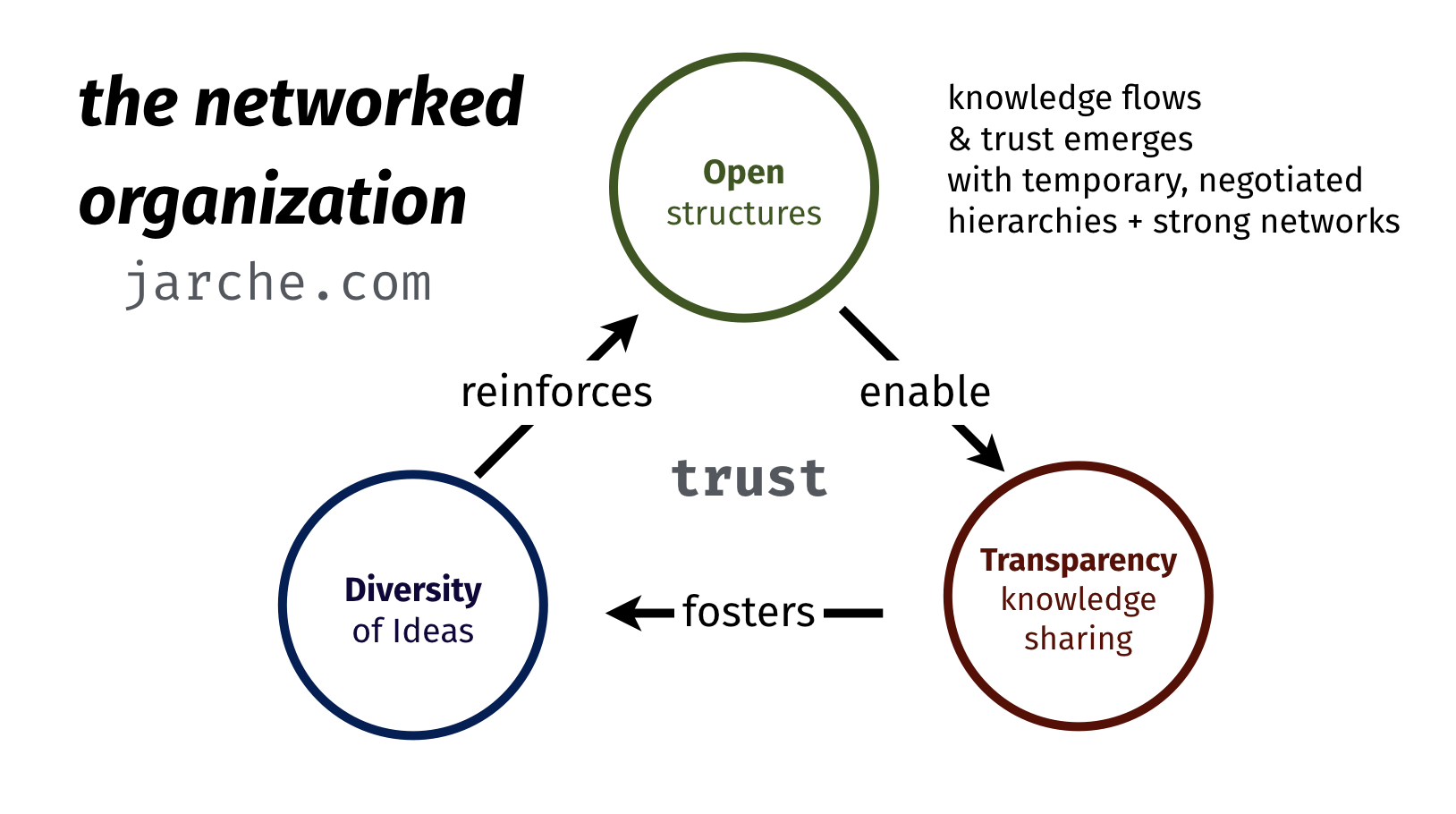
Originally published at Jarche.com
Harold Jarche works with individuals, organizations, and public policy influencers to develop practical ways to improve collaboration, knowledge sharing, and sensemaking.
PLEASE DONATE to help Network Weaver continue in it’s mission to offer free support and resources to networks worldwide.
Power of Networks: Interconnectedness Drives Change
May 5, 2021Network Weaving,The Big Picture,Blog
Our world is beset by societal challenges that are large, complex, dynamic and highly contextual. Networks can play a transformative role in resolving these challenges by sparking an interconnected web of actors and actions. Catalysing networks is key to enabling a sustainable ecosystem with diverse actors who have the capability to sense, synthesise and respond to societal problems by varied means – both normative and descriptive.
Networks are about relationships and interactions between actors in a system. Interactions can be of any type (e.g., consumes data, creates content, conducts workshops, etc.) which allow us to harness natural community responses and bridge the distance between those who need and actors who can.
In this 90 minutes webinar, Sanjay Purohit, Chief Curator – Societal Platform at EkStep Foundation, discussed the Power of Networks and covered:
- The importance of network effects and the view of a network as units of interactions – moving from 1:many interactions to many:many.
- The need to facilitate interactions between and within formal and informal networks, involving state, civil society and markets, to catalyse large-scale systemic change.
- How can digital platforms amplify the impact of these interactions and enable societal change at scale?
Sanjay Purohit, Chief Curator - Societal Platform, EkStep Foundation talks about the Power of Networks.
Originally published at Societal Platform
co-creating pathways for a resilient society
Societal Platform is a community of curators, catalysts, and network weavers. We pool our individual strengths and channel our collective imagination to enable social change leaders to advance their missions.
PLEASE DONATE to help Network Weaver continue in it’s mission to offer free support and resources to networks worldwide.
6 Tips for Making Online Collaboration More Productive and Engaging
April 26, 2021Reflection and Learning,Blog
In reflecting on a meeting I helped organize for a multi-organization, multi-stakeholder network, I realized that there’s more to online collaboration than using the right technology and best practices.
In July 2020 a survey was conducted by Collective Impact Forum about how collaboration has changed as a result of the combined effects of COVID-19, a prolonged economic downturn, and racial justice uprisings. Almost half of the challenges most commonly identified involved new ways of working together and relating to each other in an online environment. These included difficulty adapting programs to a physical distancing context, lacking the quality of experience that comes from working together in person, and encountering Zoom fatigue.
For our online meeting, an intimate experience was created by inviting attendees who faced similar challenges. Ground rules were set at the beginning of the meeting to provide a safe space for open dialogue. Network members modeled trust-based vulnerability by sharing pivotal experiences that led to broader change in their organization. Guided small group discussions enabled participants to connect with each other on a deeper level. Through an action learning approach participants gained valuable insights and identified solutions to challenges faced in their work. A break mid-way through the session provided an opportunity for everyone to step away from their electronic devices to rest and re-charge.
It takes a village to create an online community
A successful online meeting takes support. Although we often think of support in terms of tangible elements, like technology and best practices, they are insufficient on their own. There is also a human dimension to support systems that often doesn’t get talked about—unless things go wrong. What ultimately made the difference in this situation was the formation of an online meeting production team whose members were committed to achieving the same goal. Demonstrating effective collaboration behind the scenes contributed to a successful online meeting and a stronger team.
Tips for making online collaboration more productive and engaging
1. Assemble a team and bring them together early on in the planning process
Days before the online meeting the organizers realized they needed a bigger production team. Having good relationships with her co-workers made it easier for the facilitator to quickly bring a few additional people on board and orient them to their roles. Identify the different roles needed for your online meeting in advance and recruit people to fill them. Limit the number of tasks (e.g., facilitation, note taking, time-keeper, managing the technology platform, monitoring the chat, etc.) each person is expected to do so that multi-tasking doesn’t result in important details falling through the cracks. It’s also a good idea to have a back-up person whose primary function is to be ready to step in if a team member needs additional support.
2. Allocate more time for organizing online meetings
Planning for online meetings often takes longer than in-person meetings because of additional factors to be considered. Think through in advance how the meeting will take place, from start to finish, beginning with the purpose. How will you structure the meeting to accomplish your goals? How will you enable participants to actively participate? How will you support the meeting production? Help team members work together instead of assuming they will figure out what needs to happen and how to get it done on their own. This involves making sure people understand their roles and what is expected of them. Provide team members the resources and any training needed to accomplish their tasks. Determine in advance how team members will communicate with each other during the meeting, such as through texts, to share information, address problems, and make decisions.
3. Create a valuable experience for everyone
In addition to creating the content for your meeting, plan in advance the kind of experience you want to create for participants. How will you welcome people as they enter the online meeting room? Greeting each person by name as they arrive can help set a welcoming tone. How will you engage people in the conversation? Some examples are using polls, providing opportunities for people to ask questions, and building time into the agenda for reflection and sharing insights. Mixing people from different industries and sectors in virtual breakout rooms allows for conversations they wouldn’t ordinarily have that can potentially lead to breakthroughs in solving problems. Creating the space for networking, such as by randomly assigning people to breakouts, can foster spontaneous collaboration. Design your meeting so that in addition to advancing collective goals, participants come away with ideas, insights, and resources they can use in their own work.
4. Practice makes better
To ensure your online meeting runs smoothly, create a “run of show” document that explains in detail what will happen from start to finish. This includes estimated times for each section of the agenda, what resources are needed, and what tasks each team member is doing for each segment of the meeting. Organize run throughs for both speakers and the meeting team to help prepare them and test the technology. Run throughs can also foster teamwork by encouraging people to contribute their ideas for improving the meeting as well as giving and receiving help.
5. Invite people to bring their whole selves into the room
Online meetings can also serve as opportunities to engage people in a variety of ways. Design your meeting to offer more than a learning experience. Create the space for people to engage with their hearts (connect with each other on a deeper level by discussing what really matters), hands (make something together, like an action plan), and spirit (align around common goals, action items, or next steps). To learn more about this approach, check out Co-Creative Consulting’s 4 Agendas in Collaborative Innovation.
6. Create the space for learning on multiple levels
After your online meeting organize a debriefing that includes speakers, facilitators, and members of the production team to capture lessons learned about how the meeting went and the experience of working together. This can be as simple as taking turns answering these questions: What worked well? What can be improved upon for next time? Create the space for personal growth by inviting people to share what they learned about themselves from this experience.
My takeaway from working with networks in an online environment is that successful collaboration is as much about what happens behind the video camera as in front of it.
Originally published at See Change
featured image by Chris Montgomery on Unsplash
Kimberley Jutze is a social activist and founder of Shifting Patterns Consulting, a Certified B Corporation that helps changemaker leaders work better together to achieve greater impact. She specializes in helping networks and other collaborative groups increase their productivity and engagement. You can follow her on Twitter at @ShiftPatConsult and LinkedIn
PLEASE DONATE to help Network Weaver continue in it’s mission to offer free support and resources to networks worldwide.
A Journey Toward Becoming an Anti-Racist and Multicultural Organization
April 20, 2021Blog,Equity,Dismantle Racism
A note from the editor: This post is a letter sent on April 16th from The Wallace Center at Winrock International to it's friends and colleagues. Network Weaver asked to republish this letter, and the accompanying resource, because, like The Wallace Center, we also see the potential for transformational impact in sharing a story of awakening to organizational inequity and enacting systematic change. The authors write: "By sharing our own story, we might encourage others to interrogate their own blind spots, rebuild new systems and processes that prioritize equity, and shift organizational cultures"
A couple of years ago, our team at the Wallace Center undertook an honest assessment of our organization’s history, values, culture, operations, and programs to determine where we landed on the Continuum on Becoming an Anti-Racist Multicultural Organization. What we realized and learned through that reflection was painful and real, but it marked the beginning of our continuous efforts to learn, grow, and center racial equity in our organization and work.
In the spirit of accountability, vulnerability, and transparency, we want to share the Wallace Center’s Journey Toward Becoming an Anti-Racist and Multicultural Organization.
Unfortunately, the timing of this message coincides with the continued brutality against Black and Brown people at the hands of the police. This week's news reports out of Minneapolis about Daunte Wright's murder and Derek Chauvin's ongoing trial demonstrate the urgency for systems change. We will never achieve economic, environmental, and social justice without first achieving racial justice.
Learning from our past.
For decades, the Wallace Center didn’t acknowledge or address the historic and current racism that underpins our farming and food systems. We sat on the sidelines, and our passivity and complacency reinforced racism and racial inequity in the food system and in the movement to change it. Partners and funders substantiated this hard truth; that we as an organization had a lot of work to do to meaningfully center racial justice and equity in our food systems change work and dismantle white supremacy culture within our team and parent organization, Winrock International.
That reflection marked a turning point for our team. Since 2017 we have been in process to put our intentions of being a racially-just organization into practice. This has been and continues to be both a personal and organizational journey for our staff. As a predominantly white team within a predominantly white organization – historically and today – we undertake this work with a sense of humility and from a position of learning rather than knowing. Institutional inequity and white supremacy is deeply entrenched in our organizational structures and systems and is pervasive in the domestic non-profit field as well as the international development sector we are embedded within at Winrock International. This includes not only our own organization, but also those with whom we affiliate, including those who fund our work.
Moving forward, together.
This document provides a summary of our journey thus far towards centering racial justice and equity in our organization in a meaningful, authentic, and accountable way as embodied in our racial equity commitments. There are many resources linked throughout the document that have been instrumental in fueling our internal work and we hope this will be helpful for others. It is not a “how-to” guide – we are not experts in advancing racial equity in organizations – but rather a perspective of how we’re taking steps to undo racism in our organization. One such example is through the Food Systems Leadership Network’s Network Weavers conversations, in which members virtually connected to discuss ways in which our work could contribute to and advance systems change.
We can’t do this work alone.
Our learning journey has been encouraged and supported by the work of other organizations and leaders who have inspired and challenged us. We have kept much of our process and learning internal to the Wallace Center and our parent organization, Winrock International, which has more recently started the work towards equity. It is our work to do. After the killing of George Floyd last year, followed by the international uprising against institutional and structural racism, we felt that our Wallace Center journey could be a helpful reference for Winrock International and other (mostly white-led) organizations who are reckoning with their own complicity in perpetuating white supremacy and racism. By sharing our own story, we might encourage others to interrogate their own blind spots, rebuild new systems and processes that prioritize equity, and shift organizational cultures. We also agreed that sharing our journey and our commitments publicly would enable others to hold us accountable as we work towards becoming an authentic and explicitly anti-racist organization.
We want to specifically thank The Justice Collective for their partnership and support of our team, and honor the hard work and commitment of each staff member at the Wallace Center who has contributed to our evolution. We are still very much in the thick of it – the journey toward our collective liberation has no endpoint – and invite your feedback, reflections, and questions.
In solidarity,
Susan Schempf and Pete Huff, Co-Directors, Wallace Center
The Wallace Center develops partnerships, pilots new ideas, and advances solutions to strengthen communities through resilient farming and food systems. We serve the growing community of organizations, businesses, and public agencies involved in building a good farming and food system in the United States. Our program work focuses on advancing collaborative, regional efforts to grow and move good food – food that is healthy, regeneratively produced, and recognizes and builds value across the entire supply chain, from producers to farm workers, aggregators, processors, distributors, buyers, and the community based organizations supporting the food ecosystem.
featured image found HERE
PLEASE DONATE to help Network Weaver continue in it’s mission to offer free support and resources to networks worldwide.
by Susan Schempf and Pete Huff, Co-Directors, Wallace Center
Patterns of Collective Flight
April 12, 2021The Big Picture,Blog
This article is dedicated to my fellow super-connectors, movement weavers, story activators, and of course, visionary poets and meta-pattern identifiers — all of whom are seeking to create a more just and equitable world. They include: those who design new economies and value exchanges through open innovation and knowledge sharing; those who strategically connect and relation-build; those with balanced local and planetary perspectives; and those who shape regenerative solutions.

We are like the starlings who fly in free flowing formation — though the micro story patterns continuously change, we sense the emergence of a grand unified story field as we learn to cross boundaries, take creative action and fly together in one movement.
Fight or Flight
Murmuration is a great metaphor for social change. Some of the best lessons for collaboration are found in the dynamics of living systems. Who hasn’t been mesmerized by the graceful beauty of a starling murmuration? The metaphor reveals an intuitive sensing of change, both subtle and strong, in our collective heart and mind. Our inward navigation guides us to move with others who are imagining and implementing whole-systems symmetry.
My personal flight paths are often found on the liminal edge, and many of you have graciously drawn me into your circles of flight. You’ve enticed me by your creative systems imagination and welcoming appreciation. Subtly and fluidly, our flight paths flow together to harmonize in story patterns. Our multiple perspectives converge into unified vision. If one clarifies or changes their intentions, even slightly, big shifts in collective flight patterns can change an entire systems trajectory.
Murmuration reveals a dynamic living systems dance. The starling flocks shape-shift in a swirling aerial ballet while maintaining cohesion as a group. In unison, they conduct evasive maneuvers in uncertain environments often sparked by the presence of a predator species.
This dance is achieved by interacting with six or seven of one’s closest neighbors, optimizing the balance between group cohesion and individual effort. If one bird affects its seven closest neighbors, then each of those neighbors’ movements affect their closest seven neighbors through the flock. This is how a swarm becomes an intelligent cloud traveling in many directions, at various velocities.
Murmurations optimize a form of agility, neural transmissions or signals of shared information which elegantly transcend our rigid organizational diagrams attempting to define self-organization. Like passages of time and music, we resonate at deep levels of universal beauty and symmetry, understanding in ways that transcend explanation.
The science of synchronization
But for those who prefer scientific analysis, Jaymi Heimbuch talks about the science of synchronization at Mother Nature Network, “the secret lies in the same systems that apply to anything on the cusp of a shift, like snow before an avalanche, where the velocity of one bird affects the velocity of the rest.” This is known as “scale-free correlation,” and every shift of the murmuration is called a critical transition. Giorgio Parisi, a theoretical physicist at the University of Rome, lead a research team looking into the amazing movement of starlings and published a paper in the Proceedings of the National Academy of Sciences in 2010:
“The change in the behavioral state of one animal affects and is affected by that of all other animals in the group, no matter how large the group is. Scale-free correlations provide each animal with an effective perception range much larger than the direct inter-individual interaction range, thus enhancing global response to perturbations.”
Jaymi points out,“Because the size of the flock doesn’t matter, a huge flock is able to respond to a predator attack as effectively and fluidly as a small flock. No matter the size, the system works. If one bird changes speed or direction, so do the others. The question remains, however, how does an individual bird spark a change if all are busy responding to the movement of everyone else? And more importantly, how do they do it so incredibly quickly?”
And for systems geeks
Murmurations are a compelling visual representation of “complex adaptive systems.” They self-organize a spontaneous emergence of new patterns, causing adaptive reorganization. The shapes or outcomes cannot be determined since they are not designed from the “outside” (as are most human systems), but are adaptive to the flock itself.
According to systems scientists, because of their ability to process and create information, complex adaptive systems can change their behavior, co-evolve and adjust to new rules that govern relationships with their surrounding environment. These systems are sensitive enough to undergo rapid and unpredictable transformations while they seek to maintain stability and balance in the midst of internal and external fluctuations.
Murmurations also represent systems known as “edge of chaos systems” which are full of creative novelty and experimentation. These systems react to small changes in unexpected ways, communicate instantaneously, and gracefully maneuver unpredictable shifts in direction when responding to predators or roadblocks.
According to John Cleveland’s Complexity Theory — Basic Concepts and Application to Systems Thinking, “A vibrant democracy is an ‘edge of chaos’ form of governance; a healthy market is an ‘edge of chaos’ form of economics; a flexible and adaptive organization is an ‘edge of chaos’ institution; and a mature, well-developed personality is an ‘edge of chaos’ psyche.” He goes on to explain that many systems involve a closed or rigid order which make them incapable of adaptable systems evolution.
Indeed, complex adaptable systems, like nature’s systems, are abstract and thrive in perpetual motion. To some, these systems pose a threat and need to be controlled, harnessed or exploited. History is rife with tension between hierarchical social control (think mechanistic technologies, monopolies, dictatorships) and decentralized, “edge of chaos” systems.
But the great equalizing force between seemingly incoherent chaos and rigid order ideally meets somewhere in the middle on common ground. This is the sweet spot, where new regenerative systems have the opportunity to tap into the creative force of edge chaos (artists thrive in edge chaos systems btw), causing adaptive systems to grow, learn and evolve.
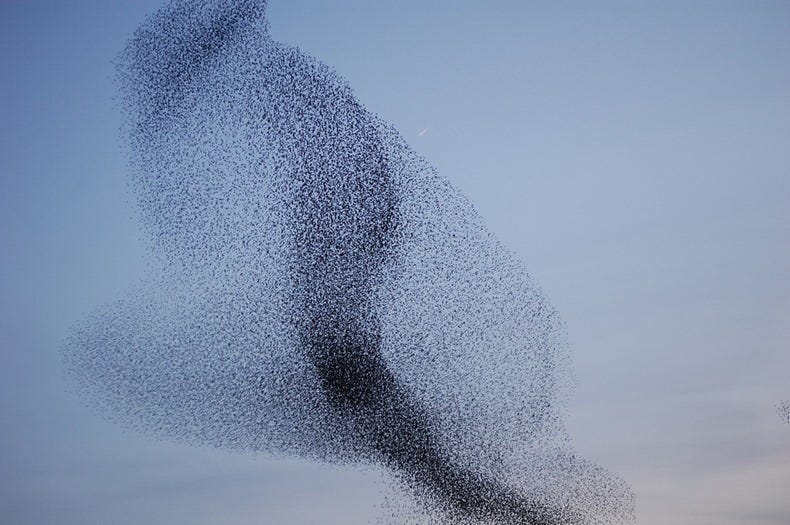
The open knowledge and story platforms set a table — a feast for resource exchange, cooperation, dreaming and making meaning. The collective flight allows for fluid moving between disciplines, sectors, siloed thinking. We become part of a dynamic “murmurating system” that leverages uncertainty while maintaining a form of consensus; a sublime coordination that consistently transitions from scattered chaos to identifiable patterns. And as we seek to learn and make meaningful connections outside of our immediate flocks, the entire pattern shifts.
Synchronization is poetry, poetry is art. Art has always been a more productive use of energy than the “fight”. The cool news is that living systems cannot be controlled by hierarchies or individual parts. Living systems are adaptable whole-systems that seek symmetry, beauty and balance.
As each of us becomes more adept at processing information that is attuned to deeper universal patterns, we can adapt by intuitively navigating complex system realities. We can not only adapt but fly, riding the air currents to higher heights while weaving new story patterns and harmonizing our aligned efforts.
Originally published at Medium.com
Thea La Grou is a visual communicator who occasionally uses words — a “creative entrepreneur,” artist, media alchemist and producer collaborating with cultural creatives, systems architects, and networked movements. She is Co-founder and Marketing Director at Millennia Music & Media, FPC, Founder and Executive Director at Compathos Foundation and is an Edmund Hillary Fellow. Author, speaker, and event producer — Thea specializes in crafting experiences that harness the shifting nuances of storytelling and bring people together to find meaningful action around the common good. Her latest ventures include TwelfthMuse, IMERSIVstorylab, and Films for the Planet— the best in environmental and social action films on demand.
________________________________________
PLEASE DONATE to help Network Weaver continue in it’s mission to offer free support and resources to networks worldwide.
Evan Welkin
Evan Welkin is a network ecosystem designer, focusing especially on high context community, social and ecological justice. As a child of the intentional community movement, he has lived and supported networks for communities seeking to build social, ecological, cultural and economic regeneration. He is completing an Ecological Design Thinking MA at Schumacher College in Devon, UK, and is cofounder of Borgo Basino folk school, ecovillage and ecotourism farm in Italy: borgobasino.org

